
Waikiki is a Honolulu neighborhood and its eponymous beach on the south shore of the island of Oʻahu in the U.S. state of Hawaii.
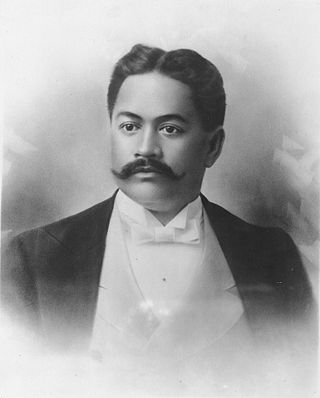
David Laʻamea Kahalepouli Kinoiki Kawānanakoa was a prince of the Hawaiian Kingdom and founder of the House of Kawānanakoa. Born into Hawaiian nobility, Kawānanakoa grew up the royal court of his uncle King Kalākaua and aunt Queen Kapiʻolani who adopted him and his brothers after the death of their parents. On multiple occasions, he and his brothers were considered as candidates for the line of succession to the Hawaiian throne after their cousin Princess Kaʻiulani but were never constitutionally proclaimed. He was sent to be educated abroad in the United States and the United Kingdom where he pioneered the sport of surfing. After his education abroad, he served as a political advisor to Kalākaua's successor, Queen Liliʻuokalani until the overthrow of the Hawaiian Kingdom in 1893. After Hawaii's annexation to the United States, he co-founded the Democratic Party of Hawaii.
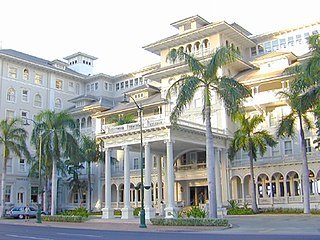
The Moana Hotel is a historic hotel building in Honolulu, Hawaii, located at 2365 Kalākaua Avenue in the Waikiki neighborhood. Built in the late 19th century as the first hotel in Waikiki, the Moana opened in 1901. It is listed on the National Register of Historic Places. The hotel was also inducted into Historic Hotels of America, the official program of the National Trust for Historic Preservation, in 1989. The building is currently part of the resort complex known as Moana Surfrider, A Westin Resort & Spa and is managed by Westin Hotels & Resorts.

The Royal Hawaiian Hotel is a beachfront luxury hotel located in Waikiki in Honolulu, Hawaii, on the island of Oahu. It is part of The Luxury Collection brand of Marriott International. One of the first hotels established in Waikiki, the Royal Hawaiian is considered one of the most luxurious and famous hotels in Hawaiian tourism and has hosted numerous celebrities and world dignitaries. The bright pink hue of its concrete stucco façade with its Spanish/Moorish styled architecture and prominent location on the wide sandy beach have earned it the alliterative nickname of "The Pink Palace of the Pacific".

ʻĀinahau was the royal estate of Princess Victoria Kaʻiulani, heir to the throne of the Kingdom of Hawaiʻi.
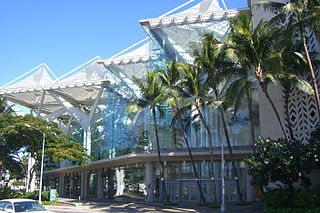
The Hawai‘i Convention Center is a convention and exhibition center in Hawaii, located in Honolulu on the island of Oahu. The Hawaii Convention Center is the largest exhibition center of its type in the state. It is located directly to the west of the Waikiki district of Honolulu.

Hawaiian architecture is a distinctive architectural style developed and employed primarily in the Hawaiian Islands. Though based on imported Western styles, unique Hawaiian traits make Hawaiian architecture stand alone against other styles. Hawaiian architecture reflects the history of the islands from antiquity through the kingdom era, from its territorial years to statehood and beyond.

Archibald Scott Cleghorn was a Scottish businessman who married into the royal family of the Hawaiian Kingdom.

King Kamehameha I Day on June 11 is a public holiday in the U.S. state of Hawaii. It honors Kamehameha the Great, the monarch who first established the unified Kingdom of Hawaiʻi—comprising the Hawaiian Islands of Niʻihau, Kauaʻi, Oʻahu, Molokaʻi, Lānaʻi, Kahoʻolawe, Maui, and Hawaiʻi. In 1883 a statue of King Kamehameha was dedicated in Honolulu by King David Kalākaua. There are duplicates of this statue in Emancipation Hall at the Capitol Visitor Center in Washington, D.C., and in Hilo, island of Hawaiʻi.

Outrigger Resorts & Hotels is a Honolulu-based luxury hotel chain and management company that operates hotels, condominiums, and vacation resort properties in Hawaii, the Asia-Pacific region, and the islands of the Indian Ocean.
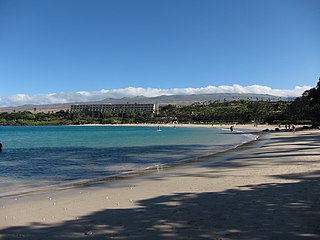
The Mauna Kea Beach Hotel is a hotel property on the Kohala Coast of the island of Hawaii. It sits at Kaunaʻoa Bay. The American Institute of Architects (AIA) awarded the hotel an Honor Award in 1967 citing its "restrained detailing and fine spatial sequences." In 2007, the hotel received honors again from the AIA as it made the top 150 of its "America's Favorite Architecture" list.

Edward Abnel Keliʻiahonui was a prince of the Kingdom of Hawaiʻi. His name means "the chief whose strength is attained through patience".

Sean Kekamakupaʻa Lee Loy Browne was born in 1953 and raised on Hawaiian Homestead Lands in Keaukaha, Hilo, Hawaii. A graduate of the Kamehameha Schools class of 1971, he earned his Bachelor’s degree at the University of Redlands in 1975 and his Master of Fine Arts in sculpture from the University of Hawaiʻi at Mānoa in 1983. In 1981 he traveled to Pietrasanta, Italy to study marble carving under Paoli Silverio and was later accepted as an artist-in-residence at Henreaux Marble Company in Querceta, Italy. In 1985 he was awarded a Fulbright Fellowship, enabling him to study stone sculpture under the guidance of Isamu Noguchi in Shikoku, Japan. For many years, Browne taught sculpture at the University of Hawaiʻi at Mānoa and at Kapiʻolani Community College.
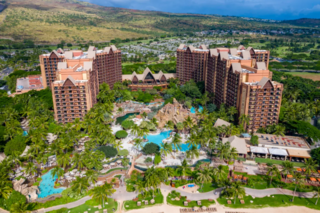
Aulani, a Disney Resort & Spa, is a beachside resort hotel at the Ko Olina Resort in Kapolei, Hawaii, on the island of Oahu. Alongside Disney's Hilton Head Island Resort and Disney's Vero Beach Resort, Aulani is Disney's third "stand-alone" hotel located in an area without any adjacent theme parks.
John Elliott, RIBA, was a British architect, who planned and designed luxury hotels and resorts. Born in Portsmouth, England, he was known principally for his contribution in the Middle East and designing 7 star hotel Emirates Palace in Abu Dhabi, United Arab Emirates.
Wimberly, Allison, Tong & Goo, also known as WATG, is an architectural firm with offices in London, Singapore, Istanbul, Honolulu, Irvine, Los Angeles, New York, Seattle and Chicago. They have designed projects in 160 countries across six continents.
The Governor H. Rex Lee Auditorium, also called Fale Laumei in Samoan, is the largest indoor meeting space in the United States territory of American Samoa. It is located in the village of Utulei, surrounded by other government buildings. The main body of the building is a roughly ovoid structure, with a curved roof that is reminiscent of the thatch roofs of traditional Samoan structures. The auditorium was built in 1962 under orders from Governor Hyrum Rex Lee as part of a major initiative to modernize the territory's infrastructure and facilities. It was built by a construction squadron of the United States Navy, and was completed in time for the 1962 South Pacific Conference. It was later named in honor of Lee, who was the territory's longest-serving governor, and oversaw much of its modernization.

Kapiʻolani was the queen of the Kingdom of Hawaiʻi as the consort of Mōʻī (king) Kalākaua, who reigned from 1874 to his death in 1891, when she became known as the Dowager Queen Kapiʻolani. Deeply interested in the health and welfare of Native Hawaiians, Kapiʻolani established the Kapiʻolani Home for Girls, for the education of the daughters of residents of the Kalaupapa Leprosy Settlement, and the Kapiʻolani Maternity Home, where Hawaiian mothers and newborns could receive care.

Kalākaua Avenue is a street in Honolulu in the US federal state of Hawaii. The street travels across the tourist Centre of Waikīkī and belongs to the prospering streets of the United States. It demonstrates an architectural fusion of Hawaiian, Gothic, Asian, Spanish and Moorish architecture.














